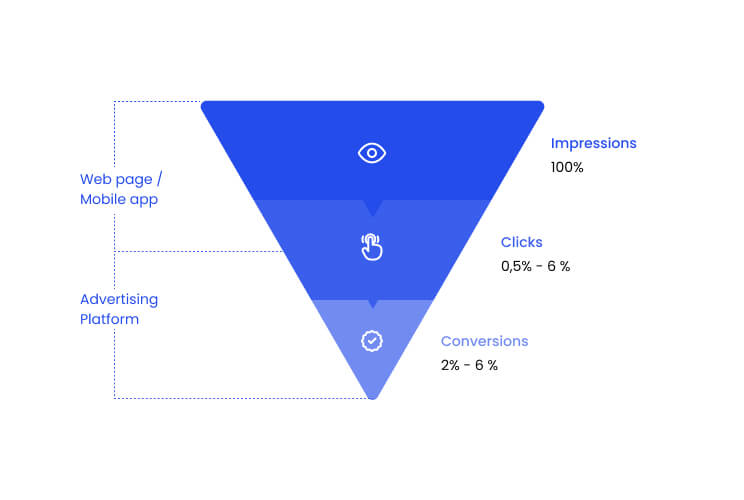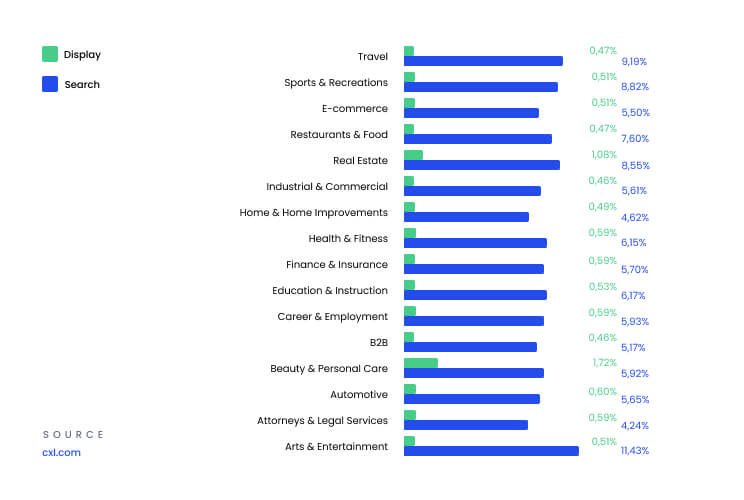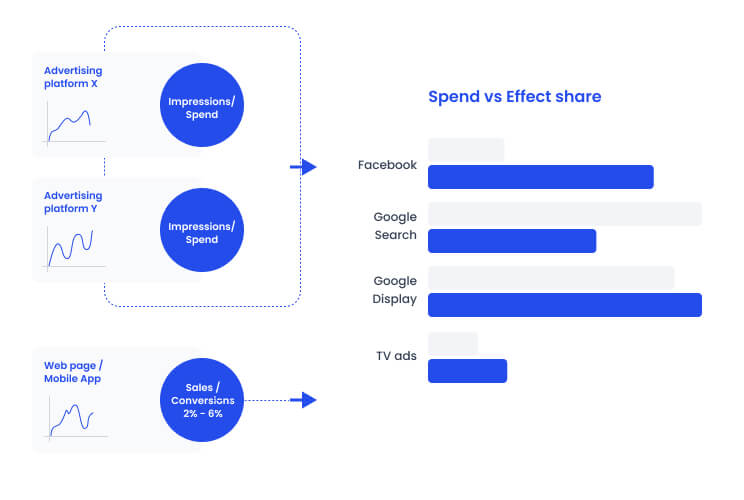Attribution – The Core Problem of Every Marketer
In this blog, we’re looking at how marketers are generally attributing and spending their effort. We’re diving into MTA in all its various forms and MMM to help you better navigate your approach.
MMM gives a top-down perspective while MTA is bottom-up approach
The first thing to note is that MMM is about measuring the quality of impressions whereas MTA (or ‘click-based attribution’) is dependent upon clicks from users. There is 20x-100x more data around impressions than there is for clicks [1] so it’s no wonder MMM is the gold standard for reporting.
Moreover, MMM takes into account your entire market mix and not just addressable (trackable) channels. Its high-level, top-down view allows you to see everything from sales and revenue, to cost information, and its position in the marketplace—plus a broad overview of how these factors interrelate.
MTA has been a great solution for (primarily) digital brands that have access to most consumer touchpoints and the ability to match a sale to a single consumer. MTA’s success has been built on the real-time assessments it provides that allow businesses to track and analyze consumer behavior in granular detail. The problem is 3rd party privacy laws are putting a wrench in how and what will be measurable with MTA.
Do You Still Believe in Click-Tracking for Attribution?
The term “touch” is used to describe the multi-touch attribution approach and is defined by Nielsen as a marketing effectiveness measurement technique that takes all of the touchpoints on the consumer journey into consideration and assigns fractional credit to each so that a marketer can see how much influence each channel has on a sale. [1]
But what exactly is a marketing touch? In most cases, it means a user is interacting with an ad in some form of direct engagement – primarily by clicking on the ad itself. Because this takes up a relatively small portion of customers interacting with ads, we feel it makes sense to call it click-based attribution.
Marketers create various online and offline interaction points for their audiences. Whether it be display creatives, videos, or keyword-based searches, there is always a cost associated with these methods. The costs can be direct to advertising channels or indirect in the case of organic content like a blog post. It’s important to measure the outcome and optimize all efforts. However, getting an understanding of the whole acquisition funnel is essential as well. The problem is that advertisers own verifiable data for only a fraction of impressions, which means they don’t have an easy way to get granular data to verify if that data is correct.
Here is a simplified view of data related to this funnel:

Impression and click data are stored and owned by the platform. Clicks are tracked on both sides and shared between the platform and the advertiser which can then be validated.
Conversion rates can be tracked directly online and fed back to the ad platform for reporting and targeting optimization. Industry click-through averages are as high as 1% for display ads and 8% for search [2]. Though you’re only measuring clicks, it’s important to note that your actual spending is based on how many impressions you get; not just how many people click through to your site. Since marketers pay for each impression (not per click), they can only measure a very small portion of their investment. There is detailed data in ad platforms and web properties, but there is no easy way to share them.

1. Media Platform Reported or “Any-Touch” Attribution – Choosing the Path of Least Resistance?
“Any-touch” attribution is easy to set up and gets reports directly from each platform natively without any third-party tools. Each platform supports tracking of conversions back to the relevant platforms by deploying a small tracking code on your webpage.
The first issue is this attribution method creates duplicates.
For example, a user clicks on a Facebook ad, navigates to LinkedIn the next day and clicks the ad there. Then, the following day they navigate to Google Ads and click the ad for a third time, sealing the deal and buying your product.
The second issue is that users opting out of third-party cookie permissions (i.e. iOS14) prevents this methodology from working entirely. Sure, it’s good to see if one campaign is performing better than another on a platform, but if you can’t attribute all of them accurately to get the big picture then you’re only seeing a fraction of the big picture.
2. Single-Touch Attribution: Betting On What You Can Easily Measure?
This is the most common and easiest type of multi-channel attribution to set up and use since it attributes all conversions to a single channel. Whether it’s last-touch attribution (Google Analytics default setting) or first-touch attribution, all conversions are attributed to a single marketing touchpoint.
The problem with first-touch attribution is it ignores all subsequent touches and gives no insights into your down-funnel metrics.
Last-touch attribution is flawed because it fails to reveal the whole story of what resulted in a conversion. While last-touch may assign 100% of conversion credit to the last touchpoint, customers are likely engaging with your brand across multiple touchpoints on various channels before they convert.
3. Already a Pro? You set up Multi-Touch Attribution (MTA):
Multi-touch attribution requires tracking every user session across your web pages or applications. The most difficult part is to identify and merge a specific user identity across sessions/devices/browsers.
For simple use cases, a standard web analytics platform is sufficient. But for more advanced use cases, a Customer Data Platform (CDP) is needed. This is the main tool for micro-optimization on a campaign or even ad level, and it actually works quite well for micro-optimizations and detailed user journeys analyses. We can see two main approaches:
Rules-Based MTA:
To include multiple user interactions and various aspects of the user journey, marketers assign steps in the user journey to different touchpoints. These assignments are often arbitrary and subjective; decisions about the rules are made an individual basis rather than with data. The most commonly used models are weighted by each touch point to create either position-based or time-decay models.
Algorithmic-Based MTA:
The most advanced models of multi-touch attributions are algorithmically based and data-driven. Different weights are assigned to each step of the tracked user journey and are calculated mathematically instead of manually assigning the weight of each touchpoint. There are many companies perfecting this and offering conversion modeling AI-based algorithms that can offer solid outcomes.
4. Do it differently – Marketing Mix Models (Non-click based)
Let’s look at how we can use impressions or general interactions without cookies or similar technologies, which track user activity across browsing sessions. MMM primarily looks to create a model that detects causation between marketing and non-marketing activities, measured results (like new users or direct revenue attribution), and predicts future results. To do this, we will not need direct data linking between input and output data; instead, data must be provided in time series format. The precision of MMM increases as data granularity increases.

There are benefits and drawbacks of this approach. It works if there is enough activity on each channel and enough variations in those activities (e.g. a wide range of impressions). Models use aggregated data so they do not require user level detailed data and work independently from tracking clicks or cookies. Models can even correlate spend directly with conversions to better represent unit of effort and include ad platform specificity. Models can even include external data (weather,holidays, events, competitors activities, etc.) which gives it an even wider ability to model overall business.
There are several approaches of MMM on a practical level and we will deep dive into those in separate articles. MMM is traditionally executed on media channel level but approach can be used also for intra-channel optimization as various research shows and can get closer to touch based attribution in regards of optimization detail level e.g. campaign category or even campaign level. MMM is typically executed separately for different geography or product category where cost and impact can be isolated.
Conclusion:
Different approaches can bring valid results depending on your marketing landscape. There is no single, perfect solution. So which approach should be selected then? Following the statement from Brainlabs can give you a hint:
“It is important to experiment with different measurement solutions, invest in the right tech, and embrace a test and learn approach to drive overall performance.”
This is where Forvio comes in.
If you’re interested in MMM to help you drive your performance and improve measurement, trial us for free today. Forvio believes MMM can be democratised to the level that can offer a viable and affordable alternative to solely tracking-based attribution and offer a tool which can compliment all click-based attributions.

